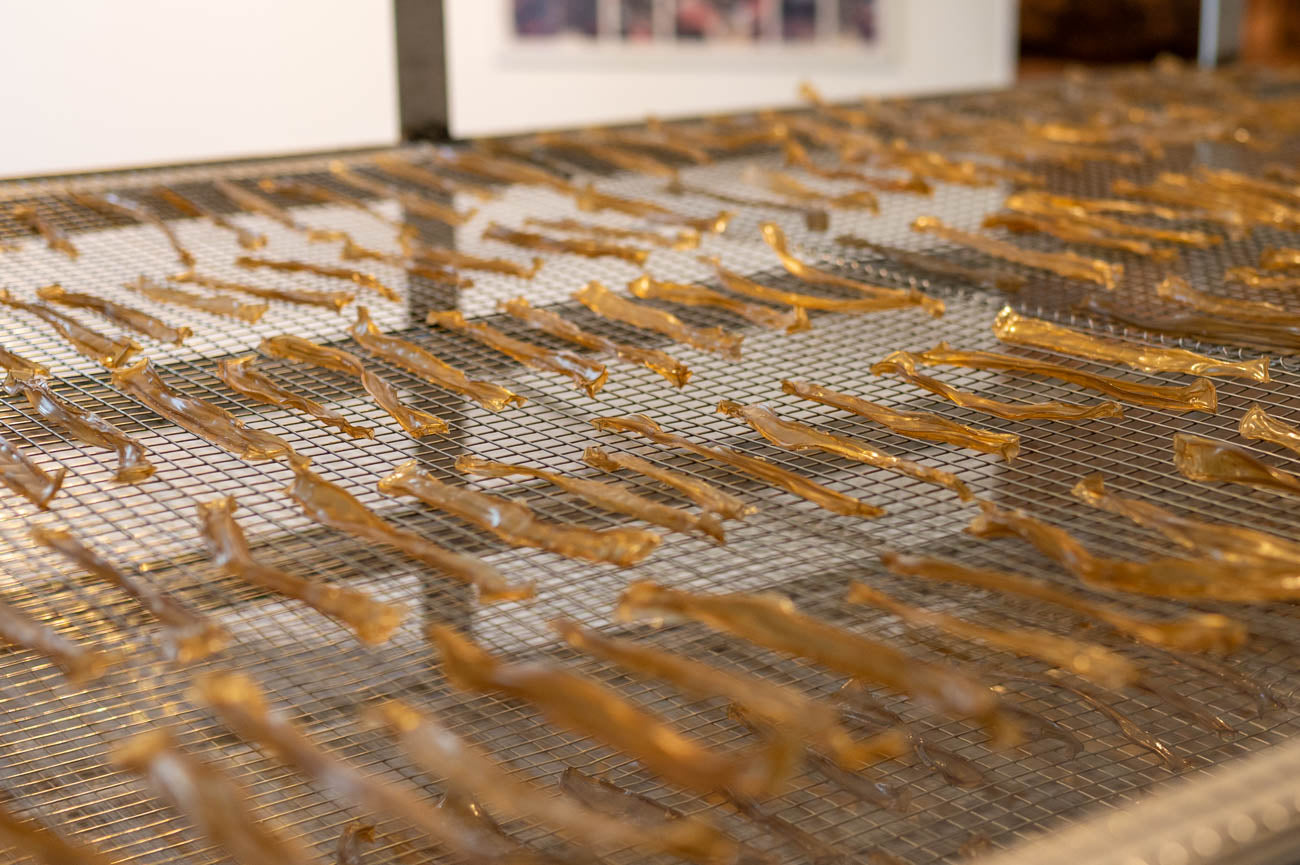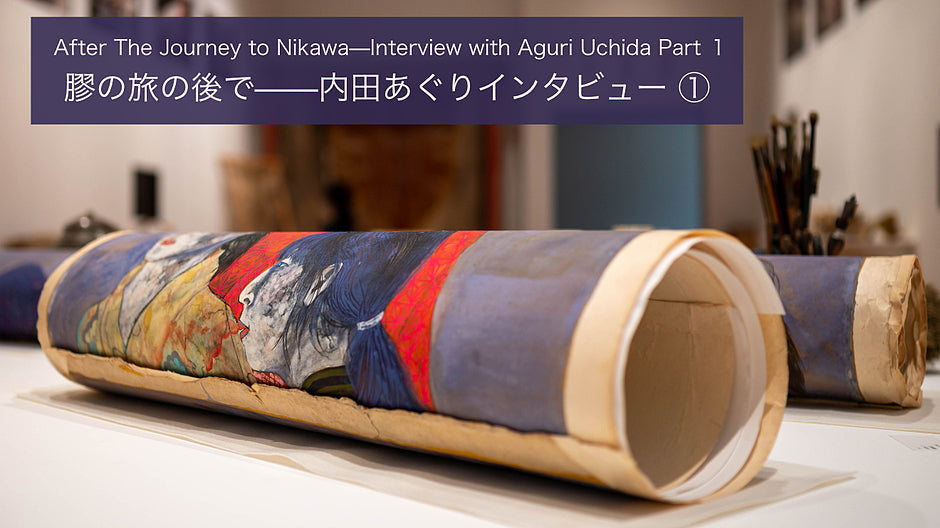“The Journey to Nikawa: Tracing the Cultural Origins” is an exhibition held at the Musashino Art University Museum & Library from May 12th to June 20th, 2021.
The exhibition not only focuses on the aspect of Nikawa (animal glue) as an art material, but also provides a glimpse of the leather industry in Japan, including the history, lifestyle, and ethnographical roots of the material.

The supervisor of this exhibition is Aguri Uchida, emeritus professor of Musashino Art University.
Through an online interview with Prof.Uchida, we asked her why she decided to create a joint research project on Nikawa, which she herself has been using for a long time in her work as an artist, and how this exhibition came about.
- This exhibition isn’t only a valuable source of educational and documentary purpose, but also created a unique installation space.
A.Uchida: Thank you very much. Materials such as Sanzenbon Nikawa (三千本膠, a type of animal glue) and the animal skins are incredibly beautiful even in their raw state, so I thought it would be a great idea to make them seen as a work of art, and they did! I wanted to convey the atmosphere of the actual working site and hope to give our visitors an authentic immersive experience.
And right after I came up with the thoughts, I immediately contacted Tomoyo Ono, the curator of MAU Museum & Library, to discuss how we can make the idea come true.

Prof. Aguri Uchida (left) and Akira Oya from PIGMENT TOKYO (right) during the online interview.
- The way you have a piece of huge cowhide and shown how they’re fully stretched in a wooden frame is pretty impressive!
A.Uchida: I know right? Those are actually from the factory of Osaki Shoten, where they stretch animal skins by using wooden frames, then hang them on huge red iron steel poles.
When I first visited the working site and thought, "This is so cool, we have to show this to the world!" and Ms.Ono along with the other staff members just agreed and said, "Let's do it." Therefore, I decided to hand the idea to them and gladly they did make the exhibition happen.
The installation of the exhibit space was done by Square 4, an incredible team with great exhibiting sense who has been helping me with my past solo exhibitions and shows.

Natsuko Shiraishi from PIGMENT TOKYO (left) and Tomoyo Ono, curator of MAU Museum & Library (right) in front of the stretched cowhide and wooden frames.
- Do you mind telling us why you decided to start the first chapter of this journey?
A.Uchida: I have been using Sanzenbon Nikawa for more than 50 years, and I have always wondered, "What is Sanzenbon Nikawa actually?” And about 10 years ago, the manufacturer of Sanzenbon Nikawa went out of business.
So, to answer my own doubt, I had this idea of what if I could master this art material by learning from the origins or history of animal glue.
Musashino Art University has this assistance system called "Musashino Art University Collaborative Research" that allows you to do all kinds of studies, so I joined and started my research in 2017 until now.
As I proceeded with my research, young researchers and photographers who were very knowledgeable about Nikawa helped me a lot, and I formed a new research unit called Team KAWA with them. I thought, "If I'm going to do this, I might as well make it fun! " (laughs)
- Look at all these pictures from the factory, they’re astounding!
A.Uchida: Thank you very much. My daughter, Ali Uchida, is a photographer, and when I asked her if she was interested in helping me with the research, she said yes.
So I had her join our research team for 3 to 5 years helping us with taking pictures and videos.

A series of pictures and videos by Ali Uchida on the exhibit wall.
- How long did it take you to create this exhibition and book?
A.Uchida: The research didn't start in earnest until 2017, and the collaborative research was only available for three years. Initially, there were no plans to publish a book, but we made a file of reports summarizing the results of the research each time and submitted them to the university. The person in charge at Kokushokankokai Inc. saw those reports and was hugely interested in our research.
And that was how the production and editing of the book started. I think it has been about four or five years since then. So, for me, the idea of publishing a book came first, and then the exhibition was created while combining that idea and the results of our research.
I believe that it is a wonderful thing to be able to give people an opportunity to reaffirm the dying culture of Nikawa through the book.

“The Journey to Nikawa”by Aguri Uchida
- I heard that you have fixed the cracks from “The Hiroshima Panel, Takahari Chouchin ''by Iri and Toshi Maruki with Nikawa in addition to your research. How did you come across Marukis' work?
A.Uchida: I really admire the works of Iri and Yoshi Maruki, especially “The Battle of Okinawa”which is a pretty huge piece (400 x 850 cm) that now belongs to Sakima Art Museum’s collection, located in Okinawa Prefecture.
The land of Okinawa itself is an important place for me, as I regularly visit there to find inspiration for my work and every time I visited I would always end up taking a look at Marukis’ work.
Osaka Human Rights Museum (located in Osaka Prefecture) also has a collection of the Marukis' works and Nikawa-making tools, so I thought it might be a great chance for me to visit and do research there.
And that was how I came across “The Hiroshima Panel, Takahari Chouchin.”

Iri and Toshi Maruki, “The Hiroshima Panels, Takahari Chouchin”, 1986, property of Musashino Art University Museum & Library
- So, from what you said, the Osaka Human Rights Museum used to own these works by Mr. and Mrs. Maruki?
A.Uchida: Originally, “The Hiroshima Panels, Takahari Chouchin”had minor cracks caused by Nikawa. Initially, the purpose of this joint research project was to investigate the problem, but then the Osaka Human Rights Museum would be closed for relocation. In response, MAU Museum & Library decided to take over this work.
Unfortunately, the Osaka Human Rights Museum is closing right now, but it owns a wonderful collection of artworks.
(*The museum is scheduled to relocate and reopen in 2022.)
-Therefore, the work itself also took quite a “journey” to finally arrived at the museum?
A.Uchida: Right, after it arrived, everyone involved in this research was concerned not only about the cause of cracks by Nikawa, but also how the fixing and restoration may affect “The Hiroshima Panels, Takahari Chouchin”, and as a result, we were able to consult and with the help of professional art conservators to fix the parts where the pigments had peeled off.
I am truly grateful to everyone who has been involved and cooperated in this joint research project.
- I think this exhibition kind of allows us to think about keywords like materials, history, and ethnography.
A.Uchida: Tsuneichi Miyamoto was a Japanese ethnologist and professor at Musashino Art University, perhaps I may have been influenced by him because of that.
It is kind of a natural flow, I would say. At first, I just wanted to know more about the background and history of Nikawa topographically and spiritually. However, the more I dug into it, the more I learned, and the result just turns out like this naturally. (laughs)

The actual drying racks that are used for dehydrating Nikawa by Osaki Shoten.
- I had never seen that large barrel-shaped device before.
A.Uchida: You put the animal skins in that device and rinse them in water, then process with chemicals, and spin them again and again.
It's pretty cool if you think about it that they used to have much bigger Taiko.

A wooden barrel-shaped spinning device called “Taiko”. A large amount of water and hides are fed into this machine, which is used in various stages of leather production.
- I feel like, in this exhibition, I was able to experience firsthand how precious the leather industry is, as well as the people who are involved in it.
A.Uchida: It certainly is. I’m glad that you get to know how the actual scene works even just a little through this exhibition.
“The Journey to Nikawa ー Tracing the Cultural Origins” is an exhibition that not only presented the state of the leather industry today but also depicted the relational connections between human with human and things to things.
In the first place, why is Prof. Aguri Uchida so passionate about researching in Nikawa?
In the second half of the interview, we will follow how she encountered and became fascinated with Nikawa in her own “journey” as an artist.
Artist Biography

Aguri Uchida
1949 Born in Tokyo
[Recent Major Exhibitions and Art Projects]
2021 The Journey to Nikawa ー Tracing the Cultural Origins, MAU Museum & Library
2020-2021 Aguri Uchida: VOICES, Maruki Gallery For The Hiroshima Panels
2020 Realism of Life: Masterpieces of Nihonga, The Museum of Modern Art, Kamakura & Hayama
2019 AGURI UCHIDA - Incarnated Painting as Inselberg, MAU Museum & Library
2015 私の素描のすべて, Gallery & Books Variété Honroku2018 1st Opening Anniversary,Saku City Museum of Modern Art Collection & “Introduction to Contemporary Japanese-Style Painting” Event, Art Museum & Library, Ota
- Numerous other solo, group exhibitions and workshops
[Honors and Awards]
1993 Studied in France as an overseas researcher of the Agency for Cultural Affairs
‘Contemporary Nihonga: 12th Yamatane Museum of Art Prize Exhibition’ Grand Prize
1999 “Survey of Contemporary Painting in Japan Exhibition’Tokyo Station Gallery Prize
2002 “The 1st Higashiyama Kaii Memorial Nikkei Nihonga Award” Grand Prize
2003-2004 Studied in New York as an overseas researcher of Musashino Art University
2019 Received the“68th Kanagawa Cultural Award”
2021 “The 2nd JAPA TENSHIN Prize”Grand Prize
Exhibition Information
「The Journey to Nikawa ー Tracing the Cultural Origins」
Advisor: Aguri Uchida (Emeritus professor of Musashino Art University)
Place: Musashino Art University Museum & Library
Venue: Gallery 4・5
Date: May 12 (Wed) - June 20 (Sun) 2021
Time: 12:00 - 18:00 (Closes at 17:00 on Saturdays, National Holidays, and Special Opening Days)
Closed: Sundays ※June 13 and 20 will be Special Opening Days
URL:https://mauml.musabi.ac.jp/museum/en/events/17300/
※The exhibition schedule may be shortened or changed based on the further circumstances of COVID-19.
※Starting June 5, MAU M&L will reopen to the public on Saturdays and Sundays only, reservation is required. Check the official website for more information.
*This exhibition has ended.

Reference
“The Journey to Nikawa”by Aguri Uchida (Kokushokankokai Inc., 2021)
Format: B5 size
ISBN:978-4-336-07184-2
Number of pages: 240
Transcription by Natsuko Shiraishi
Written and photographed by Akira Oya
Translated by Atsumi Okano, Nelson Hor Ee Herng
PIGMENT TOKYO Art Materials Expert


